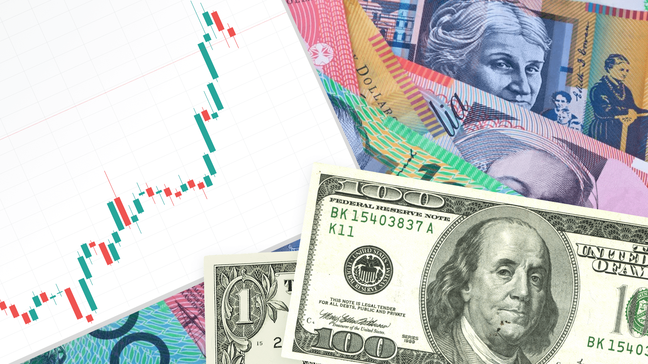Trading momentum remains light early Monday as holidays in the UK and Japan join mixed catalysts from China and the US. However, cautious optimism prevails amid the increasing acceptance of the odds favoring the Fed’s September rate cuts.
With this, the US Dollar Index (DXY) pares the biggest weekly loss in two months by posting mild gains while the US stock futures trace upbeat Wall Street performance. That said, the Asia-Pacific shared an edge higher of late.
EURUSD picks up bids to reverse Friday’s pullback from a one-month high amid hawkish bias about the European Central Bank (ECB) and the downbeat chatters about the Fed. Further, GBPUSD prints a four-day uptrend despite the British holiday, especially after Friday’s upbeat UK PMI and disappointment from the US jobs-activity data.
USDJPY rose the most among the G10 currency pairs as traders expect no more Japanese intervention to defend the Yen.
Moving on, AUDUSD remains dicey after a three-day winning streak as traders prepare for this week’s Reserve Bank of Australia (RBA) Interest Rate decision amid mixed quotes. It should be noted that NZDUSD fails to remain firmer while USDCAD also respects firmer US Dollar. Additionally, prices of Gold and Crude Oil improved amid slightly firmer risk appetite and a lack of confidence in the US Dollar’s recovery.
Elsewhere, BTCUSD edges higher after posting the first weekly gain in five whereas ETHUSD pares the weekly losses with mild gains as Crypto buyers appear optimistic about spot ETF approvals and resulted in fund flow despite the US SEC’s hard stand.
Following are the latest moves of the key assets:
- WTI Crude oil bounces off a three-week low to $78.70 by the press time.
- Gold rises half a percent to $2,313 while paring a two-week downtrend at the latest.
- The USD Index snaps a three-day losing streak despite lacking upside momentum near 105.15.
- Wall Street closed with notable gains while the Asia-Pacific shares edged higher. Further, European shares print minor gains during the initial trading hour.
- BTCUSD and ETHUSD both remain positive around $64,250 and $3,180 as we write.
US Dollar pares latest losses amid mixed clues….
Although Friday’s US employment and activity data weighed on the US Dollar, the Greenback recovered early Monday as some on the Fed desk suggest keeping the monetary policy unchanged. Additionally favoring the US Dollar bulls could be the return of the Middle East woes and the market’s consolidation of the previous moves amid a light calendar and holidays in Japan and the UK.
On Friday, the headline US Nonfarm Payrolls (NFP) eased to the lowest levels in five months while the Average Hourly Earnings also softened. Further, the Unemployment Rate rose to 3.9% versus expectations of witnessing no change in the 3.8% figure.
Apart from a softer NFP and downbeat wage growth, the disappointing prints of the US ISM Services PMI for April also weighed on the US Dollar. That said, the ISM Services PMI for April dropped to the lowest level since December 2022 while marking 49.4 figures versus 52.0 expected and 51.2 prior. The prices paid component, however, jumped to 59.2 from 53.4.
After the downbeat US data, Chicago Fed Governor Alan Goolsbee said that the Jobs reports like this will give us confidence the economy not overheating. His comments tamed expectations of witnessing a Fed rate hike and rather favored the odds supporting the US central bank’s rate cut in September.
Earlier in the day, China’s Caixin Services PMI for April eased to 52.5 versus 52.7 but marked a consecutive 16th month of expansion in the services activities. The same follows a softening in the official Non-Manufacturing PMI for the said month, from 53.0 to 51.2, to challenge the market’s optimism surrounding the dragon nation and favor the USD buyers.
While the US Dollar was recovering, the EURUSD failed to retreat amid hawkish comments from the European Central Bank (ECB) official and upbeat Eurozone data. During the weekend, ECB Chief Economist Philip Lane marked an increase in his confidence level to back the rate cuts due to the recent improvements in the inflation and GDP data. The policymaker, however, also said that more data between now and June will be received and the same will facilitate decision-making afterward. It’s worth noting that the bloc’s economics published last week suggested improvements in the GDP and inflation pressure.
Moving on, USDJPY marked the biggest move among the G10 currency pairs despite a holiday in Japan. The reason could be linked to the market’s hopes of witnessing no more rate cuts from the Bank of Japan (BoJ), as well as the broad criticism of Japan’s market intervention to defend the Yen (JPY). During the weekend, US Treasury Secretary Janet Yellen counseled caution on currency intervention after a surge in Yen.
In its annual survey of New Zealand's economy, the Organisation for Economic Co-operation and Development (OECD) cited limited space for the Reserve Bank of New Zealand (RBNZ) rate cut this year. This joined downbeat China data and the US Dollar’s corrective bounce to weigh on the NZDUSD prices.
Elsewhere, AUDUSD also remains pressured due to China news and the US Dollar’s rebound. However, the downside momentum remains limited as the Aussie traders prepare for Tuesday’s Reserve Bank of Australia (RBA) Monetary Policy Announcements. It’s worth noting that Australian Treasurer Jim Chalmers crossed wires early Monday and signaled the nation’s proximity to post another budget surplus. This could have also put a floor under the Aussie pair’s downside. Furthermore, the upbeat prints of Australia’s Job Vacancies for April, 2.8% MoM versus -1.0% prior, also helped the risk barometer pair to edge higher.
Crude Oil ignores the US Dollar’s recovery and portrays a corrective bounce from a seven-week low as Saudi Arabia raised the price of Arab Light Crude for customers in Asia for the third straight month. Also contributing to the black gold’s rebound is the recent turn in the Gaza talks where ceasefire hopes dwindled due to Hamas’ pressure for the end of the war and a permanent ceasefire before returning the hostages.
- Strong buy: USDCAD, USDJPY, US Dollar
- Strong sell: AUDUSD, NZDUSD, GBPUSD
- Buy: BTCUSD, ETHUSD, Nasdaq, Gold
- Sell: DAX, FTSE 100, BTCUSD, EURUSD
EU PMIs, ECB’s Lagarde and SNB’s Jordan eyed for intraday directions…
Moving on, an absence of Japanese and British traders will join a light calendar elsewhere to restrict the market moves on Monday. Even so, the final prints of Eurozone PMIs for April and speeches from European Central Bank (ECB) President Christine Lagarde, as well as the Swiss National Bank (SNB) Chairman Thomas Jordan, will entertain the momentum traders.
It should be noted that the US the preliminary readings of UoM Consumer Confidence and Inflation Expectations, are this week’s key data while monetary policy meetings of the RBA and the BoE will also be crucial to watch moving forward.
Given the market’s latest acceptance of the Fed’s September rate cut, the US Dollar is likely to remain pressured and can help the commodities, as well as the Antipodeans, unless the geopolitical woes escalate.
May the trading luck be with you!




